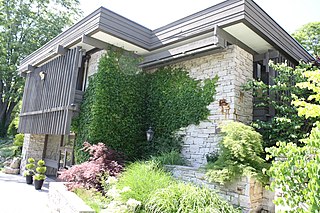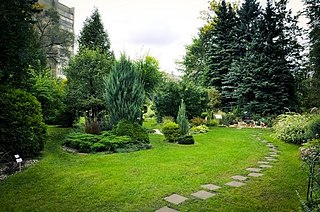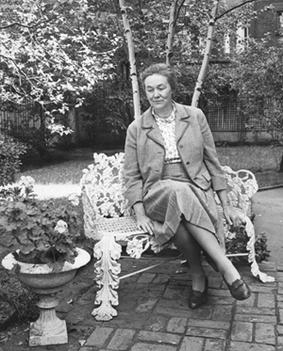
Brooklyn Botanic Garden (BBG) is a botanical garden in the borough of Brooklyn, New York City. It was founded in 1910 using land from Mount Prospect Park in central Brooklyn, adjacent to Prospect Park and the Brooklyn Museum. The 52-acre (21 ha) garden holds over 14,000 taxa of plants and has nearly a million visitors each year. It includes a number of specialty "gardens within the Garden", plant collections, the Steinhardt Conservatory that houses the C. V. Starr Bonsai Museum, three climate-themed plant pavilions, a white cast-iron-and-glass aquatic plant house, and an art gallery.

The New York Botanical Garden (NYBG) is a botanical garden at Bronx Park in the Bronx, New York City. Established in 1891, it is located on a 250-acre (100 ha) site that contains a landscape with over one million living plants; the Enid A. Haupt Conservatory, a greenhouse containing several habitats; and the LuEsther T. Mertz Library, which contains one of the world's largest collections of botany-related texts. As of 2016, over a million people visit the New York Botanical Garden annually.

The Birmingham Botanical Gardens are a 15-acre (6-hectare) botanical garden situated in Edgbaston, Birmingham, England. The gardens are located 1+1⁄2 miles (2.4 km) south-west of Birmingham city centre at grid reference SP049854. Designed in 1829, the gardens are Grade II* listed in Historic Englands's Register of Parks and Gardens, and retain many original features and layout, which was designed by the landscape gardener and horticulturalist John Claudius Loudon. The site is notable for its range of glasshouses and gardens, which display a wide variety of plants and birds. Birmingham Botanical Gardens is managed by Birmingham Botanical and Horticultural Society, a registered charity. The gardens are open daily to the public with paid admission.

Fairchild Tropical Botanic Garden is an 83-acre (34 ha) botanic garden with extensive collections of rare tropical plants including palms, cycads, flowering trees, and vines. It is located in the city of Coral Gables, Miami-Dade County, just south of Miami, surrounded at the north and west by Matheson Hammock Park.

The Kampong is open by advance reservation to visitors Tuesday through Friday and is a 9-acre botanical garden in the Coconut Grove neighborhood of Miami, Florida, United States. It is one of the five gardens of the non-profit National Tropical Botanical Garden (NTBG). An admission fee is charged.

The Chicago Botanic Garden is a 385-acre (156 ha) living plant museum situated on nine islands in the Cook County Forest Preserves. It features 27 display gardens in four natural habitats: McDonald Woods, Dixon Prairie, Skokie River Corridor, and Lakes and Shores. The garden is open every day of the year. An admission fee has been approved to start in 2022, not to exceed $35.

The California Native Plant Society (CNPS) is a California environmental non-profit organization that seeks to increase understanding of California's native flora and to preserve it for future generations. The mission of CNPS is to conserve California native plants and their natural habitats, and increase understanding, appreciation, and horticultural use of native plants throughout the entire state and California Floristic Province.

The City Parks Foundation is the only independent, nonprofit organization to offer programs in parks throughout the five boroughs of New York City. The organization works in over 750 parks citywide, presenting a broad range of free arts, sports, and education programs. Founded in 1989, it is one of the oldest and largest citywide parks organizations in the country.

DeKalb Academy of Technology and Environment (DATE) is a charter school located at 1492 Kelton Drive in Stone Mountain, Georgia, United States. The school has about 800 students in kindergarten through eighth grades.

Opelika City Schools (OCS) is a school district headquartered in Opelika, Alabama. The district is accredited by the Alabama State Department of Education and the Southern Association of Colleges and Schools. The school system enrolls approximately 4,300 students on nine campuses. Opelika has three primary schools with grades K–2, Southview, Jeter, and Carver, three intermediate schools with grades 3–5, West Forest, Northside, and Morris Avenue, Opelika Middle School with grades 6–8, Opelika High School with grades 9–12, and one at-risk school, Opelika Learning Center. Opelika's schools have traditionally had strong programs in technology and the arts.
The Edible Schoolyard (ESY) is a 1-acre (4,000 m2) garden and kitchen program at the Martin Luther King Jr. Middle School, a public middle school in Berkeley, California. The Edible Schoolyard was established in 1995 by chef and author Alice Waters and is supported by the Edible Schoolyard Project, a non-profit founded by Waters in 1995 in celebration of the 25th anniversary of her famed Berkeley, California restaurant, Chez Panisse.
The Delta Study is a CBSE syllabus high school in Kochi, India. Established in 1976, Delta Study has approximately 1000 students and 47 teachers.
Circular Head Christian School is an independent school in Circular Head, North-Western Tasmania.

The Toronto Botanical Garden (TBG) is located at 777 Lawrence Avenue East at Leslie Street, in Toronto, Ontario, Canada. Termed "The little garden with big ideas", the TBG is nearly four acres and features 17 themed "city-sized gardens". Located in the north-east corner of Edwards Gardens, the TBG is a non-profit horticultural and educational organization with a mission to connect people, plants and the natural world through education, inspiration and leadership.

Botanical Garden of Tver State University — the northernmost botanical garden with an exhibition of steppe plants, only one of its kind in the Upper Volga. Located in Zavolzhsky Tver region, near the confluence of the Volga Tvertsa. It is valued as a site of historical, cultural and natural heritage besides being an archaeological monument.
Loveland Learning Garden is a non-profit community school garden program located in the Loveland City School District in Loveland, Ohio. As "the largest and most comprehensive school gardening program in the Midwest," Loveland Learning Garden's collaborates with the Loveland City School District to offer hands-on learning experiences for students that are directly connected to state curriculum standards. Granny's Garden School has begun the Schoolyard Nature Network to aid those who wish to develop their own school garden programs. Hailed as a "tremendous community asset," Granny's Garden provides food for the school cafeteria as well as to the rest of the community. Granny's Garden School is featured prominently in Herbert W. Broda's book Moving the Classroom Outdoors: Schoolyard-Enhanced Learning in Action. Broda lauds the school as, "a truly amazing enterprise It has also been presented in the American magazine Birds and Blooms.

Alice Recknagel Ireys was an American landscape architect whose notable clients included the Brooklyn Botanic Garden, the New York Botanical Garden, the Clark Botanic Garden, the Abigail Adams Smith Museum, and the Brooklyn Museum.
Gateway Greening is non-profit organization based in St. Louis, Missouri that works to educate and empower the community through gardening and urban agriculture. The organization operates demonstration and community resource gardens and an urban farm, hosts lectures and education programs, and supports school and community gardens throughout the City and St Louis County, Missouri.

Howard Samuel Irwin Jr. was an American botanist and taxonomist who specialized in the genus Cassia and worked as an administrator at the New York Botanical Garden, Long Island University, and the Brooklyn Botanic Garden.

Elizabeth H. Sutherland Elementary School is a public K-8 school located in the Beverly neighborhood on the south side of Chicago, Illinois. It is part of the Chicago Public Schools system. The school is named for Chicago educator Elizabeth "Bessie" Huntington Sutherland, the first woman principal in Cook County. The current building was opened in 1925, one year after Sutherland's death.
















